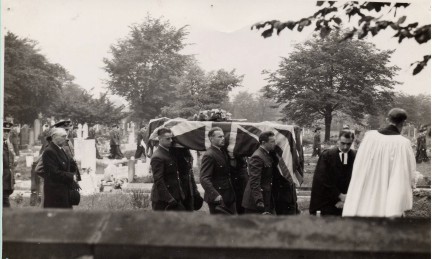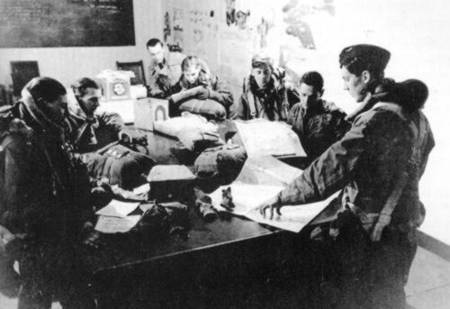
 |
At Hullavington there were forty-five officers on the course which was due to last until 21 November 1944. Those attending were not only RAF but included Canadians, Australians, Rhodesians, South Africans, Dutch and US Navy and Air Force representatives. Their ranks ranging from Flight Lieutenant up to Wing Commander, all having achieved in excess of 1,000 hours flying experience. During the three weeks David spent at Hullavington he flew almost every day, practising and demonstrating aircraft handling, stalling and spinning procedures and performing aerobatics. He gave lectures on bombing and other operational techniques and spoke on administrative procedures related to Bomber Command.
On 15 September 1944, David, accompanied by four other officers, paid a flying visit to 61 OTU at RAF Rednal, near Oswestry in Shropshire, to acquaint themselves with the training courses being undertaken and assess the ability of the establishment to fulfil them. They flew in an American built Martin Baltimore, a light bomber, with David at the controls. They arrived without incident.
Staying overnight, they boarded the aircraft for the return flight to Hullavington, this time with a Squadron Leader Westley in the pilot’s seat. A young WAAF, Margaret Hay was on duty in the Rednal Control Tower that afternoon. Fifty-five years later she explained to me that the St.Leger horse race was to be run shortly and the staff were speculating on the likely winner. Looking out onto the south-west runway in front, she could see the Baltimore at the northern end, preparing to depart. Being a Spitfire station, the presence of such an unusual aircraft was a topic of interest. She recalls overhearing two airmen discussing the characteristics of the machine and one remarking that, due to the internal upper and lower seating arrangement, in the event of an accident, it would be difficult for members of the crew to evacuate. She was relieved to see machine clear the runway but appalled to observe, seconds later, that it was in trouble. Horror stricken, she watched it disappear beyond the trees of Tedsmore Hill, the only prominence in the locality, and then witnessed the rapidly rising pall of black smoke. She immediately summoned the emergency services. There was no further interest in the big race.
Leonard Powell, an RAF engine mechanic at Rednal, was off duty at the time. He was billeted close by and raced to the scene of the tragedy on his bicycle, to render what assistance he could. He was the first to arrive. The Baltimore had broken up into pieces strewn on both sides of the narrow lane skirting the east boundary of Tedsmore Hall and on towards the hamlet of Henbarns. Scrambling over the hedge onto the downhill landfall, he came across the lower compartment of the aircraft with two crew members strapped inside, these being David and a Major Cross of the South African Air Force. Both were past human aid. Before he could turn his attention to the other part of the fuselage, which had come to rest several hundred yards further along the lane, the emergency services arrived to find that those members of crew, seated higher in the machine, had survived.
The Official Accident Report stated that the aircraft crashed immediately after take off, the pilot having lost rudder control and being unable to keep the nose of the machine from dropping. The Accident Investigation Branch, looking closely at the tail assembly, found the locking mechanism (which prevents the rudder from flapping in the wind whilst the aircraft is parked) was still partially applied, thus preventing full movement. There was also a suggestion that some sort of engine failure had occurred.
Thus ended, tragically, the life of an exceptional and beloved man who, as a pilot, had over 1,200 hours of flying to his credit and had survived the hazards of forty-seven operational sorties flown against the enemy.
At the request of his family, the body of David was brought back to Burn and the Squadron to which he had given so much for the funeral service and then to be interred in Selby Cemetery.
Flight Sergeant Len Roberts, air gunner, recalled:
It was a great shock when I was called to the Station Adjutant’s office and asked to find five other aircrew of my rank and similar height to collect the Wing Commander’s body from Selby station - I couldn’t believe what I was hearing. We brought the coffin to the airfield draped in the Union Flag. At the funeral I was the Chief Wreath Bearer, following the Wing Commander’s family into the Station Chapel. I stood behind the coffin during the service with tears streaming down my cheeks and on to my tunic but I was not able to wipe my eyes as I had a wreath in each hand. It is something I shall never forget.

An entry in the 578 Squadron Operation Record Book of 20 September 1944 stated:
The funeral took place of Wing Commander D S S Wilkerson DSO DFC, late Commander of the Squadron. The funeral service took place in the StationChurch. Squadron Leader B P K Watts and Squadron Leader S V Hollis the Church of England and Other Denomination Padres officiated. The interment took place in the Services Plot in Selby Cemetery. The funeral was attended by Mr and Mrs J S Wilkerson and Flying Officer Wilkerson, the father, mother and brother of the deceased. Also present were the Air Officer Commanding No. 4 Group, Air Vice Marshal Carr CB CBE DFC AFC, Air Commodore J L Kirby CBE commanding No. 41 Base, the Station Commander Group Captain J Warburton and the Squadron Commander, Wing Commander A G T James OBE. Representatives of Headquarters No. 4 Group and of Stations and Units in the Group also attended. Personnel from the Squadron lined the route from the Church to the Hearse and marched past the graveside paying their last compliments to one who had not only been their Squadron Commander, but had also earned their deepest respect and affection. Known to all as ‘WILKIE’, Wing Commander D S S Wilkerson DSO DFC will never be forgotten by any who served with him.
Tributes appeared in the London Gazette, National newspapers such as The Times, The Daily Telegraph and in the local press of Selby and Woodford. More poignant are the recollections of Squadron airmen of all ranks and trades and civilians, particularly when one remembers that the association, in most cases, would have been only for a few months.
I operated on three trips from 77 Squadron, Elvington and six from 51 Squadron at Snaith. Thirty more were with 578 which was to me by far the happiest Squadron. This I feel was due to the character of Wing Commander Wilkerson who led his troops from the front. Our loss rate was lower than with the previous two Squadrons, from which I deduced that a happy Squadron is also an efficient one. ‘Winco’ was a great Commander and a gentleman who made 578 in his own image. We knew when we saw his name on the operations list that we were in for a tough trip for it was his policy to lead from the front on such dangerous occasions
Flight Lieutenant GeorgeBird: Navigator
I knew DavidWilkerson (affectionately known as ‘Winco’) as a fine courageous airman, a great leader, a highly respected person, a true friend and an avid supporter of all members of the Squadron he commanded. As a leader his displayed compassion, understanding and a keen appreciation of those whom he led in the most difficult of times. He was a man quick to acknowledge a good performance, while being personally helpful to those who were experiencing difficulties from time to time in carrying out the exacting duties expected of them. A successful organisation can only achieve through the example from the top and DavidWilkerson, by his admirable stature, set that great example from which excellent bombing operations were obtained. The records of the Squadron would confirm my belief in this assessment. His untimely and unfortunate death cut short not only a brilliant service career but what, I believe, would have been an outstanding contribution to society around him had he been spared beyond his service life.
Flight Lieutenant Vic Ferry DFC: Australian Pilot

Wing Commander Wilkerson (standing) briefs his crew before taking-off on an operation
I remember Wing Commander Wilkerson as a man who literally inspired us to get out and get going. His briefings were as comical as a comedian’s and he never made any bones about what lay ahead of us. When his name appeared on the crew list for an operation, we knew it was going to be a tough night.
Flight Sergeant JohnWadia DFM: Flight Engineer
I flew with Wing Commander Wilkerson on two operations and found him to be an excellent pilot with a great sense of fun. When a raid to Berlin was aborted, we had turned to come home, I was nearest to the rations but before I could put my hand on them the ‘Winco’ had beaten me to it.
Flight Sergeant Ron ‘Nosmo’ King: Wireless Operator
Wing Commander Wilkerson - it’s a job to know where to begin. If I start by saying that, in my opinion, not only was he an officer and a gentleman but he was looked upon more as a colleague by everyone whether he was an officer or an ordinary airman. Nothing was too much trouble. If you had any little problem you could go to him at any time and he would put you right. He made you feel, no matter what rank you were, that an AC2 was just as important as himself to make a successful Squadron. This bond continues today, fifty-five years later.
Aircraftsman DudleyBrown: Flight Mechanic
I remember Wing Commander Wilkerson as the ‘Best Boss’ I’ve ever had in and out of the RAF. He was human in his relationships with all the staff. Courageous and modest, he led the Squadron by example and every member of it would give his all for the ‘Winco’.
Flying Officer JohnBluring DFC: Pilot
Wing Commander Wilkerson was my Captain, thus, I have many treasured moments. Both on ‘Ops’ and off duty, we were quite close and good friends. ‘Wilkie’s’ coolness in a difficult situation became legendary. His usual response to concerned queries from the crew was “Keep your heads in the office and leave me to do the flying.” He was responsible for saving my life.
Flight Sergeant JohnDavis DFM: Flight Engineer
‘Wilkie’ had a gift of leadership and the ability to use it. Most of us in the Squadron would have preferred death than to do anything which he would consider to be dishonourable.
Flight Lieutenant TonyHorton DFC Pilot
In November 1944, the United States Air Force accorded David the exceptional honour of a posthumous Silver Star award. The citation read:
For gallantry in action against the enemy while participating in many attacks on some of the most heavily defended targets in Germany. His ability to anticipate enemy tactics and defences was invaluable, while his fearlessness in combat and offensive spirit have been an inspiration to his fellow fliers and reflect highest credit upon himself and the Armed Forces of his Country.